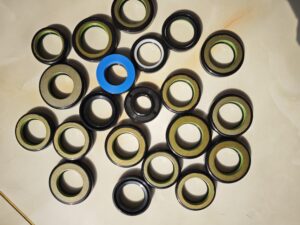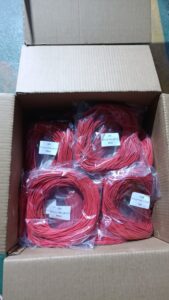Table of Contents
ToggleAre O-rings and Seals the Same?
O-rings and seals are critical components in mechanical systems, often discussed interchangeably. However, they are distinct in design, functionality, and application. This article clarifies their relationship, differences, and unique roles in engineering.


Understanding Seals: A Broad Category
What Is a Seal?
A seal is a general term for any device or material that prevents the leakage of fluids (liquids or gases), retains pressure, or blocks contaminants between mechanical components. Seals are indispensable in industries ranging from automotive to aerospace, ensuring system efficiency and safety.
Key Functions of Seals:
- Leak Prevention: Stop unintended fluid or gas escape.
- Contamination Exclusion: Protect systems from external particles.
- Pressure Containment: Maintain internal pressures in pumps, engines, and pipelines.
Common Types of Seals:
- Gaskets: Flat or shaped materials (e.g., rubber, metal, cork) clamped between static surfaces like pipe flanges.
- Lip Seals: Flexible seals with a spring-loaded lip for rotating shafts (e.g., oil seals in engines).
- Mechanical Face Seals: Paired rigid surfaces (often ceramic or carbon) used in high-pressure pumps.
- Labyrinth Seals: Non-contact seals with tortuous paths to impede leakage in turbines.
- O-Rings: Circular elastomeric rings compressed in grooves for static or low-motion joints.
O-Rings: A Specialized Subset of Seals
What Is an O-Ring?
An O-ring is a torus-shaped (doughnut-like) elastomeric seal designed to fit into a machined groove (gland) between two mating surfaces. Its circular cross-section enables compression, creating a zero-clearance barrier against leaks.
Key Characteristics:
- Geometry: Defined by inner diameter (ID), cross-section thickness, and material hardness (durometer).
- Materials: Elastomers like Nitrile (NBR), Viton® (FKM), Silicone (VMQ), and EPDM, chosen for chemical/thermal resistance.
- Installation: Compressed within a gland to generate sealing force.
Applications:
- Static Seals: Hydraulic fittings, pipe joints, and valve covers.
- Dynamic Seals: Low-speed reciprocating or rotating systems (e.g., pneumatic cylinders).
Key Differences Between O-Rings and Other Seals
1. Design and Geometry
- O-Rings:
- Torus shape requiring a precision-machined groove.
- Relies on compression for sealing.
- Gaskets:
- Flat or custom-shaped; no groove needed.
- Seals via flange compression.
- Lip Seals:
- Spring-supported flexible lip for radial shaft sealing.
2. Functional Scope
- O-Rings:
- Versatile for liquids, gases, and mild chemicals.
- Limited to low-speed dynamic applications.
- Mechanical Face Seals:
- Handle extreme pressures (e.g., industrial pumps).
- Lip Seals:
- Optimized for high-speed rotating shafts (e.g., crankshafts).
3. Cost and Complexity
- O-Rings:
- Low-cost, simple installation.
- Single-component design.
- Mechanical Seals:
- Multi-part assemblies (e.g., springs, secondary seals).
- Higher manufacturing and maintenance costs.
When to Use O-Rings vs. Other Seals
Optimal Uses for O-Rings:
- Static Applications: Flange joints, hydraulic systems.
- Low-Motion Systems: Pneumatic actuators, slow-rotating shafts.
- Cost-Sensitive Projects: Simple, mass-produced machinery.
When to Choose Alternatives:
- High-Speed Rotation: Lip seals or mechanical face seals.
- Flat Surface Sealing: Gaskets for pipelines or engine blocks.
- Extreme Pressures: Mechanical seals in chemical pumps.
Conclusion: Distinct Yet Related
- O-Rings Are Seals, But Not All Seals Are O-Rings:
While O-rings fall under the broader category of seals, their toroidal design and reliance on compression distinguish them from other types like gaskets, lip seals, or mechanical seals. - Selection Criteria:
- Motion Type: Static vs. dynamic.
- Pressure/Temperature: O-rings for moderate conditions; specialized seals for extremes.
- Cost and Maintenance: O-rings offer simplicity and affordability.
In summary, O-rings and seals are not the same. O-rings excel in specific scenarios, while the term “seal” encompasses diverse solutions tailored to unique engineering challenges.



Leave A Comment